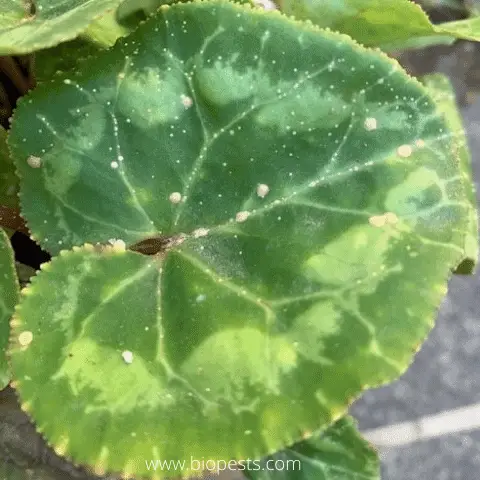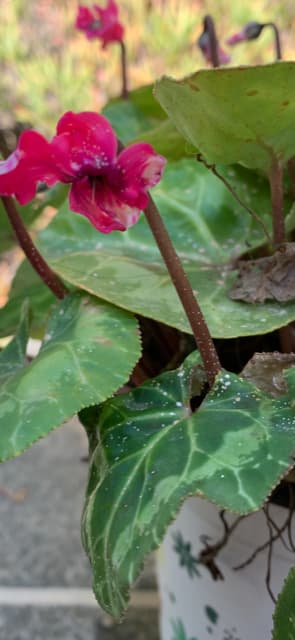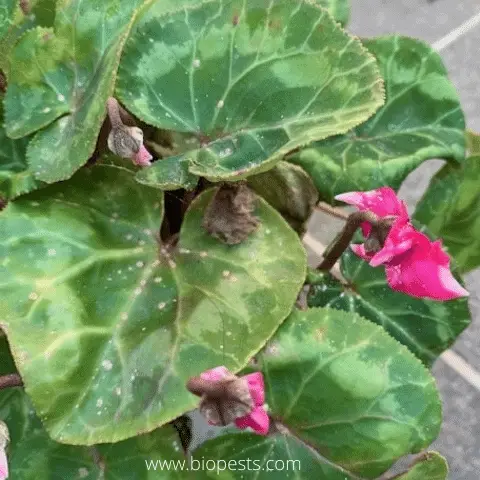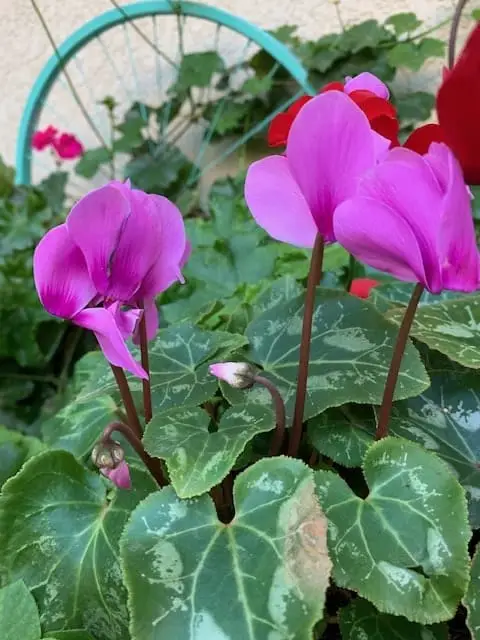Cyclamen are perennial bulb flowers that brighten our autumns and winters by giving us beautiful blooms. With their dark green leaves and brightly colored flowers, they can embellish any windowsill.
They are usually very robust flowers and if kept well, they should not give any problems and should bloom again from year to year. We are normally used to seeing cyclamen on window sills or in sheltered areas in the house. In regions, with temperate climates, these flowers are well suited to living outdoors, or planted in the garden.
I have several plants of cyclamens of different colors and they live outside, on my porch. Usually, towards the end of the summer and with the first signs of the autumn season, cyclamen begin to show their first buds. This year I noticed that one plant did not grow at the same rate as the others. The leaves showed white speckles and the buds were late, few, and deformed. This is when I realized that my cyclamen have been attacked by scale.
How to recognize scale on cyclamen leaves
Scale are very small white insects. Their size is just a few millimeters and it is difficult to identify them with the naked eye. They are a close relative of aphids. In nature, there are about 7,000 different species, all belonging to the Rhynchota family.

Scale does not like sunny locations, so it prefers to attack plants that are in shady and poorly ventilated areas.
Usually, one realizes the presence of an infestation when it is already in an advanced stage.
There are several types of scale parasites. In the case of the cottony scale, the parasite will be easily identifiable due to the whitish spots that are created on the leaves and which resemble cotton balls.
Scale initially appears on some leaves as a group of small white dots. As the days go by, these dots increase in size and propagate on other leaves, stems and flowers as well.

Despite being small, this parasite is much feared by farmers and gardening enthusiasts because it feeds on the sap of plants by attacking their leaves, branches, buds, and fruits. This parasite spares no one: it can affect both house and garden plants, and fruit trees!
The parasites attack the leaves in correspondence with the lymphatic channels from which they draw their nourishment. The attack leads to a weakening of the plant and, if not taken in time, to death.

Prompt intervention is a determining factor in the fight against the parasite, but, as I said before, even an expert eye may not immediately notice the presence of the insect due to its size.
These pests are carriers of various diseases that are harmful to plants. They have a great resistance to all climatic conditions and external agents, such as pesticides that are found on the market.
To be sure that your cyclamen plant have actually been attacked by scale you need to check for these three signs:
- The appearance of spots on the leaves tend to get worse with each passing day
- Leaves starting to turn yellow and beginning to shrivel
- Presence of ants on the plant
The presence of ants on the plant is due to the fact that the ants are attracted to the honeydew, a sugary secretion produced by the scale insects. Just as they do with aphids, ants “farm” scale insects, which means they provide their protection in exchange for the honeydew.
The abundant emissions of honeydew produced by scale, in addition to attracting the attention of ants, contribute to the development of sooty mold, a disease caused by fungi, and is recognized by the presence on the leaves of a black and dusty layer.
If you want to know how to get rid of sooty mold, read here.
8 Ways to get rid of scale on Cyclamen leaves organically

Scale is not a very mobile insect and does not move quickly. It is possible to remove the parasite manually. This is certainly the cheapest and most ecological method and at the beginning of the infestation, it is the first thing to do. Right after treating the plant, the best thing to do is to expose it to direct sunlight, in order to create a hostile environment for the remaining parasite.
Here is a list of 8 natural remedies to eradicate scale:
- Horticultural oil: it is a mineral oil, derived from the refining of petroleum, which is diluted in water and vaporized on plants. It creates a thin layer that covers both insects and eggs causing them to die from asphyxiation. Being an oily substance of mineral origin similar to paraffin, it is good to remember not to spray it on the leaves in the summer because this could reduce leaf transpiration and lead to a deterioration of the plant. If it rains after an application, the treatment must be repeated.
- Pruning the branches or leaves: when a plant is attacked by this parasite, their physical elimination is definitely a recommended action to do.
- Castile soap or Marseille soap treatment: dilute a little Marseille or Castile soap with water. Take some cotton balls and press them on all the affected leaves. The soap clogs the pores of the insect causing its death;
- Neem oil: it is a completely natural insecticide to be diluted in water and sprayed directly on plants. Neem oil acts with a variety of functions: it affects the respiratory system of the parasite, interrupts the feeding of insects, and acts as a deterrent for egg-laying. Repeat the treatment even 3 or 4 times until there is a total disappearance of the parasites.
- Tea Tree Oil: Make a water-based spray with a few drops of tea tree oil. Spray directly on the infested leaves. It is an excellent repellent that creates an environment hostile to the proliferation of the insect. The treatments that use oil-based substances and which act as repellents on the scale need to be repeated for a few days.
- Denatured alcohol: wet a cotton swab with alcohol and rub it directly on the parts affected by the scale insects. After each treatment, rinsing with water must be carried out;
- Garlic: it is an effective natural pesticide with a repellent action and a powerful natural antibiotic and antifungal. Prepare a decoction to vaporize directly on the leaves. You can learn how to do it here.
- Use ladybugs: Ladybugs are beneficial insects for our garden and natural predators of scale. Ladybugs will not hesitate to devour as many examples of scale as possible! If the problem of scale infestation occurs in greenhouse plants, it is possible to buy live ladybirds online in large numbers and release them inside the greenhouse. Here is an article about ladybugs and other beneficial insects that are a great ally for us gardeners.
What are the most favorable conditions for the development of scale?
Scale loves and reproduces in hot and dry environments. This means that the summer months will present the most at risk. Plants kept indoors are more at risk of becoming infected as there are ideal conditions for the formation and reproduction of this parasite.
Why Scale attack cyclamen plants?
As I said before, cyclamen is a fairly robust plant and not so prone to scale infestations. However, it is likely that before scale attacked your cyclamen plant it was probably already weakened due to some fungal disease. For this reason, it is essential to treat your cyclamen plant with an antifungal spray once the treatment against scale is finished.
How to prevent scale from returning
To avoid our plants from being attacked by this dangerous parasite, it is good to implement a preventive action.
The first and undisputed enemy of scale is water.
It is therefore a good thing to always feed your plants with the right amount of water. A humid environment will disadvantage the conditions for the reproduction and propagation of this parasite.
Not surprisingly, the rain itself is much feared by scale and therefore helps to eradicate their proliferation.

Some of the links above are affiliate links, meaning, at no additional cost to you, I will earn a commission if you click through and make a purchase.
